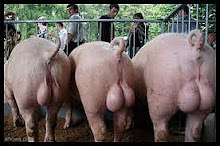Daeji Bulgogi basically translates to pork fire meat. Thinly sliced pork is grilled over a red hot fire. The pork is flavored and spiced up by a Korean chile paste called gochujang. It provides plenty of kick and makes you sweat big time. A Korean friend of mine gave me a container of gochujang so the first thing that came to mind was to slap it on a big chunk of pork.
On its own, daeji bulgogi (I love the name) is just pork. It is usually not eaten alone, you need to serve it with some bang-it-home additions and side dishes to fully complement the pork. I chose to serve the daeji bulgogi with Tofu Kimchee Stew.
Here is what you need to marinate the pork:
- 2 lbs pork shoulder, I used pork shoulder steaks, sliced into thin strips/bits
- 1/4 cup soy sauce
- 1 tablespoon sesame oil
- 2 tablespoon rice wine
- 1 tablespoon, or heaping spoonful of chile paste, gochujang
- 4 bulbs of garlic, minced
- 2 tablespoons brown sugar
- 1 teaspoon black pepper
- 2 teaspoon salt
- 1 medium onion
- 2 green onions
- 1 teaspoon red pepper flakes
Combine all ingredients and mix together to cover the pork. Place in the refridgerator for a few hours or preferably overnight.
Get the grill ready after the meat is done marinating. Set your grill up for direct or indirect grilling. I like to grill indirect for slow-cooked meat.
I also used a grill tray so I wouldn't lose a piece of pork through the grates. If you use a grill tray, preheat it on the grill for a few minutes before adding the meat.
Grill direct on each side of meat for a minute or two. Remember, the pieces of pork are cut thin so be careful to not overcook them.
I moved the tray over to the indirect side to slow-cooked the pork after the sear. Also, I chose to cook the Kimchee stew on the grill so I needed to make room for my pot.
To utilize the Daeji Bulgogi, I made Tofu Kimchee Stew. Here is what you need to make the stew:
- Soft or firm tofu, drained and cubed
- One jar of mild or hot kimchee
- 1 onion, sliced
- heaping spoonful of gochujang
- water to cover ingredients in pot
- handful of daeji bulgogi
- salt/pepper to taste
As the pork was resting on the indirect side, the kimchee stew took about 12-15 minutes to cook. Just keep a watchful eye on the pork. Again, I want to make my point about not overcooking the thinly sliced pork. If it gets overcooked, it turns tough and chewy like cardboard and ruins the food experience.
The meat had a good kick to it from the spicy chile paste and the pork shoulder was a good cut to use as it was tender and moist. The pork would taste great over a simple bowl of white steamed rice but really, you need to pump it up a little bit, pack up some big flavors. The tofu kimchee stew was the perfect fit for it.
The kimchee added a good bite to the stew. The cabbage made it nice and crunchy. The gochujang turned the broth into a spicy shade of orange. I added about 2 tablespoons mixed into the stew and it really turned up the heat of the dish but it wasn't too overpowering.
The pork could have been cut into smaller pieces but I thought it tasted perfect with the spices and vegatables. Instead of using white onion, I should have cut up more green onions and garnished the stew with cilantro but otherwise the dish was fantastic.
This dish was quite easy to make and the flavor was off the charts. Impress your friends or make your girlfriend/boyfriend real happy. Just let that orange broth drip down your chin and sweat bead up on your brow. It is all worth the effort.











No comments:
Post a Comment